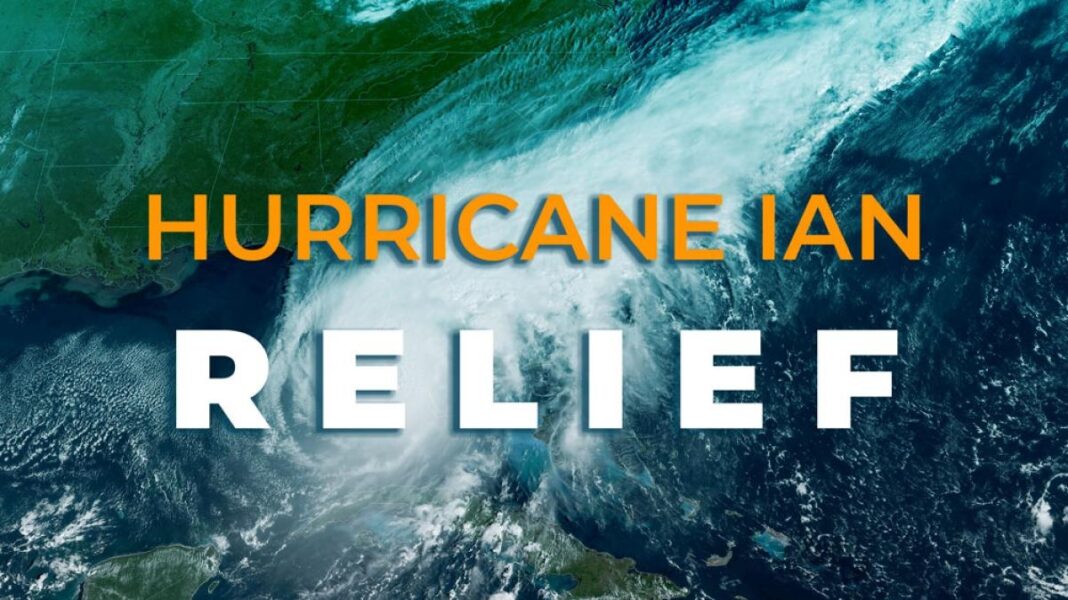Resources from FEMA – for more details, visit: https://www.fema.gov/disaster/hurricane-ian
Resources to Jumpstart Recovery
- Florida survivors who live in Charlotte, Collier, DeSoto, Flagler, Hardee, Hillsborough, Lee, Manatee, Orange, Osceola, Pinellas, Polk, Putnam, Sarasota, Seminole, St. Johns and Volusia counties and affected members of the Seminole Tribe of Florida can apply for federal assistance at www.disasterassistance.gov, by calling 800-621-FEMA (3362) or by using the FEMA App. Survivors using a relay service, such as a video relay service, captioned telephone service or others, give the FEMA operator the number for that service. More than 83,000 survivors have applied for assistance to help begin their recovery.
- Small Business Administration disaster loans are available to businesses, homeowners, renters and nonprofit organizations in some Florida counties. Applicants may apply at disasterloanassistance.sba.gov under declaration #17644. For help, call 800-659-2955 or send an email to DisasterCustomerService@sba.
gov. - The Florida Division of Emergency Management has a webpage dedicated to emergency information for Hurricane Ian survivors. Visit www.floridadisaster.org/info.
- If you are one of the 1.6 million Floridians, 76,000 Georgians or 201,000 South Carolinians with flood insurance, contact your insurance agent or carrier to file your claim immediately even if you’re evacuated and suspect flood damage. Be sure to ask them about advance payments. The National Flood Insurance Program has ample adjuster resources available to process claims quickly and fairly. To learn more about how to start your flood insurance claim, visit Floodsmart.gov.
- Mental health resources are available. Survivors experiencing emotional distress can call or text the Disaster Distress Helpline at 800-985-5990. The national hotline provides free 24/7, crisis counseling for people who are experiencing emotional distress related to any natural or human-caused disaster. Deaf and Hard of Hearing ASL callers can use a videophone or ASL Now.
- Florida residents who did not evacuate but now need to leave their home can visit www.floridadisaster.org/
shelter-status for open general and special needs shelters in Florida. If you do leave your home, do not leave pets or animals behind. - Florida residents can call the Florida State Assistance Information Line at 800-342-3557 to receive up-to-date information regarding Hurricane Ian.
- Medically dependent residents of Florida who need electricity to operate medical equipment, transport services to evacuated due to a medical condition or need help getting medication during a disaster can register for assistance at FloridaDisaster.org/SNR.
- If you need assistance locating a missing friend or relative call the Red Cross at 800-733-2767 and provide as much detail as you can to assist us in potentially locating your missing loved one. You can also complete a form at missing.fl.gov for yourself or with the last known location of your loved one(s). This information will help rescue workers locate you and your loved ones as quickly as possible
- The National Center for Missing & Exploited Children has free reunification assistance for children and families impacted by disasters. If you or someone you know is missing a child related to a disaster or any other incident, please immediately call 911 and then 800-THE-LOST for assistance.
- The Internal Revenue Service announced tax relief for individuals and households affected by Hurricane Ian that reside or have a business anywhere in the state of Florida. If you are in one of the designated Florida counties for individual assistance or a member of the Seminole Tribe of Florida, you now have until Feb. 15, 2023, to file various individual and business tax returns and make tax payments.
- Floridians who use Veterans Affairs medical centers and clinics and need urgent care services should call 877-741-3400. Find a list of open VA centers at Find VA Locations | Veterans Affairs. Additionally, the Heritage Health Emergency Pharmaceutical Refill Program is activated in Florida, call at 866-265-0124, option 1 with questions. The hotline is open Monday through Friday from 7 a.m. to 11 p.m. ET, and weekends from 9 a.m. to 5:30 p.m. ET. Veterans needing emergency refill locations can visit va.hhspharmacy.com/locations/
index.html. - Visit Hurricane Ian | FEMA.gov for information and resources available for Florida residents affected by the storm. The page is available in Creole, Simplified Chinese, Portuguese, Spanish and Vietnamese.
How to Help
After a disaster, people come together to help. To make the most of your contributions, it’s important to follow guidelines for donating and volunteering responsibly.
- Please do not self-deploy. If you want to volunteer as part of the Hurricane Ian recovery, visit Florida’s official volunteer portal at VolunteerFlorida.org to find volunteer opportunities.
- Think long term. There will be volunteer opportunities for months, often years, after the disaster. A list of agencies with volunteer opportunities can be found on the National Voluntary Organizations Active in Disaster website at www.nvoad.org.
- Cash is the best donation. After a disaster, people always want to help, but it’s important to donate responsibly. When people support voluntary organizations with financial contributions, it helps ensure a steady flow of important services to the people in need after a disaster. find national and local charities at www.nvoad.org.
USACE announces start of Blue Roof Program in response to Hurricane Ian
The U.S. Army Corps of Engineers has been tasked by the Federal Emergency Management Agency (FEMA) to assist eligible homeowners with temporary roof repairs. The Operation Blue Roof program will begin on Oct. 3 to provide a temporary blue covering with fiber-reinforced sheeting to help reduce further damage to property until permanent repairs can be made.
Operation Blue Roof is a free service to homeowners. The counties that have been identified are Charlotte and Lee. The initial sign up period is set for 21 days and will end on Oct. 23.
Residents impacted by Hurricane Ian can sign up at Blueroof.us. Here, you can sign up for Blue Roof assistance using a Right of Entry (ROE) form, which gathers information about your residence. The ROE is a legal document that allows Corps workers to access your property and assess your home’s damage. The ROE also allows contracted crews to work on your roof.
Operation Blue Roof is a priority mission managed by the U.S. Army Corps Engineers. It protects property, reduces temporary housing costs, and allows residents to remain in their homes while recovering from the storm. This program is for primary residences or a permanently occupied rental property with less than 50 percent structural damage. Vacation rental properties are not eligible for this program.
After the blue roof is installed, the structure is declared habitable. Not all roof types qualify for the program. Roofs that are flat or made of metal or clay, slate, or asbestos tile do not qualify. All storm debris must be removed for the roof to qualify.
Residents can also call toll free 1-888-ROOF-BLU (1-888-766-3258) for more information.
Safety Considerations for Residents
- Beware of frauds and scams. All FEMA employees carry an official badge. Federal and local disaster workers do not solicit or accept money. Don’t trust anyone who offers financial help and then asks for money or personal information. Call the FEMA helpline at 800-621-3362 right away if an inspector comes to your house, but you haven’t applied for assistance. This might be a sign of identity theft.
- Stay out of floodwater. Standing water may be electrically charged from underground or downed power lines or contain hazards such as human and livestock waste, contaminants that can lead to illness, sharp debris or wild or stray animals. Do not walk, swim or drive through flood waters.
- Be careful when cleaning up. Wear protective clothing, including work gloves and sturdy thick-soled shoes. Do not try to remove heavy debris by yourself. Use an appropriate mask if cleaning mold or other debris. People with asthma and other lung conditions and/or immune suppression should not enter buildings with indoor water leaks or mold growth that can be seen or smelled.
- Be safe using generators. Generators can help during a power outage but can present serious health and safety risks. Only use a generator outdoors and far from open doors and windows. Visit www.ready.gov/power-outages to learn how to use a generator safely.
- Avoid downed power or utility lines. They may be live with deadly voltage. Stay away and report them immediately to your power or utility company. Do not cut or cover fiber optic cables with debris.
- Stay off the roads. Emergency workers may be assisting people in flooded areas, restoring electricity or cleaning up debris. You can help them by staying out of the way and off the roads. If you evacuated do not return home until local officials tell you the area is safe.
- Place debris wisely. Never place debris near trees, structures or downed powerlines. This makes removal difficult.
- Keep paying attention to local officials. If you evacuated because of Ian, keep in mind that flooding is still happening in many locations. Roads may be blocked and power is still being restored. Only return once local officials say it’s safe and you have access to food and water.
State, Federal Response Actions
- In Florida, thousands of Florida National Guard members and National Guard members from other states are activated to help with the response.
- Administrator Criswell reiterated FEMA’s support for all Ian survivors as the agency continues responding to other active disasters. As of Sunday, FEMA had nearly 10,000 staff deployed to support open and active presidentially declared disasters. This includes more than 2,400 supporting Ian response efforts, 890 in Missouri, 780 in Puerto Rico and 520 in Kentucky.
- More than 670 staff are supporting FEMA’s call centers and FEMA is working on contract support for additional operators to assist. Additionally, federal personnel from the Internal Revenue Service and the Census are supporting FEMA’s call centers. As of Sunday, 400 IRS staff and 250 Census staff were helping or training to help answer survivor calls for assistance and minimize wait times.
- More than 850 emergency management personnel from other states have been deployed to Florida through the Emergency Management Assistance Compact.
- DHS Secretary Alejandro Mayorkas activated the DHS Surge Capacity Force. The Surge Capacity Force is composed of nearly 7,500 members from other federal agencies who can help augment FEMA’s disaster staffing.
- Power restoration continues across Florida, thousands of personnel working to continue restoration where electricity can be restored. Nearly 70% of peak power outages have been restored and fewer than 800,000 power outages remain.
- The state of Florida provided 4,000 gallons of diesel to Lee County to power emergency generators to supply water to nearby hospitals. The state is also delivering 1.2 million gallons of water from Lakeland to Fort Myers for hospitals without water.
- More than 550 U.S. Army Corps of Engineers personnel are conducting safety inspections, installing generators and assessing power needs.
- Generators arrived at the Generator Staging Base in Immokalee, Florida. The Defense Logistics Agency is delivering additional generators to Craig Field, Alabama in anticipation of state requests.
- FEMA and its feeding partners are serving tens of thousands of meals per day and are working with state partners to increase that capacity daily. Large scale feeding operations will increase this week.
- Points of distribution began distributing food, water and ice in Lee and Charlotte counties.
- The U.S. Environmental Protection Agency has two mobile labs in Gainesville and Fort Myers to increase water analysis capacity.
- FEMA activated a medical support contract for ambulances and paratransit seats. More 840 missions have been completed.
- FEMA’s Incident Management Teams, Mobile Communications Operations Vehicles and Mobile Response Support teams are deployed in Atlanta, Fort Myers, Miami, Orlando, Tampa and Tallahassee supporting response efforts.
- U.S. Department of Health and Human Services declared a Public Health Emergency for Florida and South Carolina. HHS Disaster Medical Assistance Teams under the National Disaster Medical System are supporting medical centers in Charlotte, Lee and Sarasota Counties. Other medical support including task force teams, pharmacists and the Kidney Community Emergency Response program for people who need dialysis.
- U.S. Immigration and Customs Enforcement Routine non-criminal immigration enforcement operations will not be conducted at evacuation sites, or assistance centers such as shelters or food banks. Additionally, officers will be vigilant against any effort by criminals to exploit disruptions caused by the storm.












